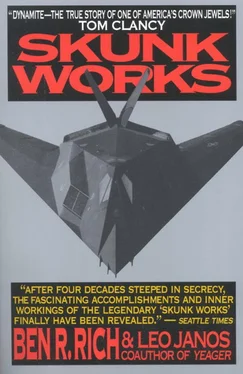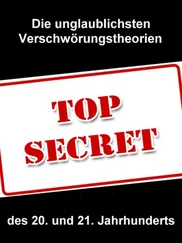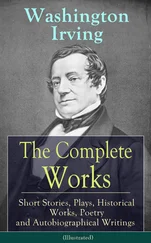Even worse, I began picking up rumors that certain officials at the Pentagon were accusing me of rigging the test results of the radar range competition against Northrop. An Air Force general called me, snarling like a pit bull. “Rich, I’m told you guys are pulling a fast one on us with phony data.” I was so enraged that I hung up on that son of a bitch. No one would have ever dared to accuse Kelly Johnson’s Skunk Works of rigging any data, and by God, no one was going to make that accusation against Ben Rich’s operation either. Our integrity was as important to all of us as our inventiveness. The accusation, I discovered, was made by a civilian radar expert advising the Air Force, who had close ties to leading manufacturers of electronic jamming devices installed in all Air Force planes to fool or thwart enemy radar and missiles. If stealth was as good as we claimed, those companies might be looking for new work.
His motivation for bad-mouthing us was obvious; but it was equally apparent that we were unfairly being attacked without any effective way for me to defend the Skunk Works’ integrity from three thousand miles away. So I invited one of the nation’s most respected radar experts to Burbank to personally test and evaluate our stealth data. MIT’s Lindsay Anderson accepted my invitation in the late summer of 1976 and arrived at my doorstep carrying a bag of ball bearings in his briefcase. The ball bearings ranged in size from a golf ball to an eighth of an inch in diameter. Professor Anderson requested that we glue each of these balls onto the nose of the Hopeless Diamond and then zap them with radar. This way he could determine whether our diamond had a lower cross section than the ball bearings. If the diamond in the background proved to be brighter than the ball in the foreground, then the ball could not be measured at all. That got me a little nervous because nothing should measure less than an eighth-of-an-inch ball bearing, but we went ahead anyway. As it turned out, we measured all the balls easily—even the eighth-of-an-inch one—and when Professor Anderson saw that the data matched the theoretical calculated value of the ball bearings, he was satisfied that all our claims were true.
That was the turning point for the entire stealth adventure, which could have ended right there if Lindsay Anderson had reinforced the accusation that we were being unscrupulous and presenting bogus data. But once he corroborated our achievement back in Washington, I was informed by a telegram from the Air Force chief of staff that Have Blue was now classified “Top Secret—Special Access Required.” That security classification was rare—clamped only on such sensitive programs as the Manhattan Project, which created the first atomic bomb during World War II. My first reaction was “Hooray, they finally realize how significant this technology really is,” but Kelly set me straight and with a scowl urged me to cancel the whole damned project right then and there.
“Ben,” Kelly warned me, “the security they’re sticking onto this thing will kill you. It will increase your costs twenty-five percent and lower your efficiency to the point where you won’t get any work done. The restrictions will eat you alive. Make them reclassify this thing or drop it.” On matters like that, Kelly was seldom wrong.
Other Voices
General Larry D. Welch
(Air Force Chief of Staff from 1986 to 1990)
In 1976, I was a brigadier general in charge of planning at the Tactical Air Command at Langley, Virginia, when my boss, General Bob Dixon, called me one afternoon and told me to drop whatever I was doing to attend an extremely classified briefing. He said, “The only people I’ve cleared for this briefing are you and one other general officer.” I went over to headquarters and discovered that Ben Rich of Lockheed’s Skunk Works was making a presentation about producing an operational stealth aircraft. Bill Perry, who ran R & D at the Pentagon, had sent him over to us because Dr. Perry was very interested in the stealth concept and wanted our input. Ben spoke only about twenty minutes. After he left, we went into General Dixon’s office and he asked, “Well, what do you two think?” I said, “Well, sir, from a purely technical standpoint I don’t have a clue about whether this concept is really achievable. Frankly, I’m not even sure the goddam thing will fly. But if Ben Rich and the Skunk Works say that they can deliver the goods, I think we’d be idiots not to go along with them.” General Dixon wholeheartedly agreed with me. And so we started the stealth program on the basis of Ben’s twenty-minute presentation and a hell of a lot of faith in Ben Rich & Company. And that faith was based on long personal experience.
Way back when I was a young colonel working in the fighter division—this would be the early seventies—I was tasked to come up with a realistic cost estimate for a revolutionary tactical fighter with movable wings called the FX, which later became the F-15. Inside the Air Force there was a lot of controversy about costs that ranged from $3.5 million to $8.5 million. Before we could ask Congress for money, we had to reach some sort of consensus, so I persuaded my boss to let me go out to the Skunk Works in Burbank and get their analysis because they were the best in the business. So I flew out and sat down with Kelly Johnson and Ben Rich. After drinking exactly one ounce of whisky from one of Kelly’s titanium shot glasses, we got down to business. Ben and Kelly worked out the figures on a piece of paper—Okay, here’s what the avionics will cost, and the airframe, and so on. The overall cost they predicted per airplane would be $7 million. And so we went to Congress and told them that the FX would cost between $5 million and $7 million. The day we delivered that airplane the cost came out to $6.8 million per airplane in 1971 dollars.
So I had supreme confidence that Ben and his people would deliver superbly on stealth. There were only five of us at headquarters cleared for the stealth program, and I became the head logistician, the chief operations officer, and the civil engineer for the Air Force side. The management approach we evolved was unique and marvelous. Once a month, I’d meet with Dr. Perry at the Pentagon and inform him about decisions we required from him as Under Secretary of Defense. Sometimes he agreed, sometimes not, but we never had delays or time wasted with goddam useless meetings. Because we were so highly classified, the bureaucracy was cut out and that made a tremendous difference. Frankly, that was a damned gutsy way to operate inside the Pentagon, but the reason we could afford to be so gutsy was our abiding faith in the Skunk Works.
Before the government would sign a contract with me I had to submit for approval a security plan, detailing how we would tighten all the hatches of what was already one of the most secure operations in the defense industry. Hell, we already operated without windows and behind thick, eavesdrop-proof walls. We had special bank-vault conference rooms, lined with lead and steel, for very sensitive discussions about very secret matters. Still, the Air Force required me to change our entire security system, imposing the kinds of strictures and regulations that would drive us all nuts in either the short or long run. Every piece of paper dealing with the project had to be stamped top secret, indexed in a special security filing system, and locked away. Full field investigations were demanded of every worker having access to the airplane. They imposed a strictly enforced two-man rule: no engineer or shop worker could be left alone in a room with a blueprint. If one machinist had to go to the toilet, the co-worker had to lock up the blueprint until his colleague returned.
Читать дальше












